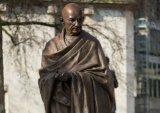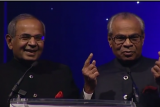On Realms of Existence
World, as everyone knows is ever changing. All beings are changing. Mind is fleeting in nature. Therefore, such changing, decaying and transient world and objects of the world cannot fit his definition of Sat. At the same time, world cannot be dismissed as non-existing, because there is the world with names, forms, actions, results and experiences. There is the cosmos with the Sun, the Moon, the Planets, the Stars, , the Oceans, the Mountains, the Earth, the Beings - all of which being seen and experienced by us. Hence, the universe though ever in flux, does exist but if evaluated against the scale of eternal Absolute Existence it has only a Relative existence (Mitya) as Adi Sankara calls it.
Adi Sankara classifies Non-existence in two categories, namely, deluded existence (Maya) and Absolute Non-existence (Asat). Snake on rope , silver on nacre and ghost on post are classic examples of illusory but nevertheless perceived as existing. These are believed and seen as true and existing even though for a while only. This is super imposition of one on another of same kind or form. This phenomenon causing the appearance of one for another is termed Maya. It is this Maya that deludes us to think the world as the ultimate reality, veiling the substratum, the Absolute existence, The Brahmn. Thus the world we see it exists when we are deluded and upon dawn of knowledge it vanishes, revealing the ultimate reality.
More like this
The phenomena that projects the ultimate reality, Brahmn to be experienced as the world is Maya. From where does this projecting power arise? It cannot be from a source different from Brahmn for that would lead us to infinite regress. Can Maya be the same as Brahmn? No it cannot be because Maya vanishes upon dawn of knowledge. Therefore it is in the nature of Brahmn to cause Maya phenomena. Has this declaration sanction of authority of Upanishads? The answer is yes.
“From that whole came this whole
Even after this whole came from that Whole,
That whole remained whole”
This Upanishad declaration can be true only if “this whole” (this universe) is valued zero because of its vanishing existence to the Jnyani. ‘Om Tat Sat’, ‘Tat Tvam Asi’, ‘Aham Brahmasmi’,’ Pragnyanam Brahmam’ , ‘ I am AtmaBrahmam’, ‘Soham’, ‘Sarvam Brahmam’, ‘Satchitananda’ ; these great axioms of Vedic texts testify to Brahmn as the Absolute Existence, Absolute Knowledge and Absolute Bliss.
Any other phenomena or vastu not covered by these three categories (Sat , Mitya and Maya) is Absolute Non-Existence (Asat). That which is non-existing, never existed and will never exist is Asat. eg: horns of a horse, sun of a barren woman.
The ultimate reality and the substratum is only One. That ‘One without a second’ is Brahmn. Maya projects that One as different and various. We need to get rid of this dual perception. Maya effect causing perception of our ephemeral world as the real veiling the ultimate reality, i.e, Brahmn, is a phenomena at the universal plane. At the individual level, the phenomena of ephemeral body-mind-intellect complex being perceived as our true self, veiling the ever present & eternal Self , i.e, ‘Atman’ is called Avidya, i.e, Ignorance or Delusion. Our identification with non-self (body-mind-intellect complex) causing egoistic feelings of I-ness & my-ness leading to bondage & consequent miseries are all due to ignorance of our real I, i.e our Real Self.
Vedic texts such as ‘Aham Brahmasmi’ (I am Brahmn),’ Tatvamasi’ (Thou art that), ‘Ayam Atma Brahmn’ (Self is Brahmn),’ Soham’(I am He) - all clearly point to the truth that “Self in me is the Self in All” and that Brahmn embodied is Self & Self disembodied is Brahmn – like pot-space and space, bubbles & water, waves & ocean – just names and forms. Therefore, only if we give up our dual perception and realize the Oneness of beings, the result of perception of otherness, namely, lust, anger, fear, hatred, envy and greed - these products of dualism - can we be freed from.
Brahmn cannot be cognized, is beyond thought because how can the knower be known? Brahmn can however be inferred from our day-to-day experience. Darkness implies light; Experience of different tastes implies a tasteless tongue. Motion pictures can be seen only on a fixed screen, so also, the ephemeral & ever-changing world and objects of the world, i.e, Relative Existence, should certainly imply the truth of the eternal & the unchangeable Absolute Existence, i.e, Brahmn.
It is true that we were deluded into seeing snake on a rope, but it is equally true that snake could have been perceived without the fact of rope being there. It follows therefore, that delusion must always presuppose a substratum on which takes place. “Deluded existence” of the ephemeral world must imply the eternal, unchanging, Absolute Existence , as the substratum of everything in the universe.
N Balasubramanian is an old time honours graduate in economics and has vast experience and expertise in human relations and resources development. A devotee of Sage of Kanchi - Maha Swamigal, N Balasubramanian is living a quiet and meditative life based upon the Guru's teachings. An avid reader of philosophy in his younger years, he wholly devotes his energies presently, in discovering insights and practical wisdom from ancient Indian scriptures. Based upon his understanding of Acharya's discourses and writings on spirituality, N. Balasubramanian shares these thoughts on IndiaNewsBulletin.com to just provoke your thoughts and kindle your interest in spirituality and philosophy.
Most read
- 2015: Full list of Indian States, capitals and their Chief Ministers
- Indian cabinet 2014: Full list of Ministers and their portfolios in the Modi government
- South Indian actress Trisha Krishnan’s father passes away
- Recipe: Misal Pav – how to make missal masala, usal and tarri
- Review: Southall Travel (Also Travel Trolley and Fly Sharp)
- Ileana D’Cruz and Virat Kohli sizzle in TV ad for Clear anti-dandruff shampoo
- Review: VFS Global Joint Visa Application Centre in Paddington
- FCNR rates comparison
- Commonwealth Games 2014: Full list of Indian gold, silver and bronze medal winners
- Pics: Deepika Padukone and Irrfan Khan’s blossoming chemistry in Piku
India News Bulletin by email
Desi Events
Featured Stories
More Lead Stories
- Review: Southall Travel (Also Travel Trolley and Fly Sharp)
- Mahatma Gandhi statue erected in London’s Parliament Square
- Pics: Deepika Padukone and Irrfan Khan’s blossoming chemistry in Piku
- Pics: Priyanka Chopra and Freida Pinto back the ‘Girl Rising’ campaign in India
- Tamannaah sizzles at Audi Ritz Icon Awards 2014






















